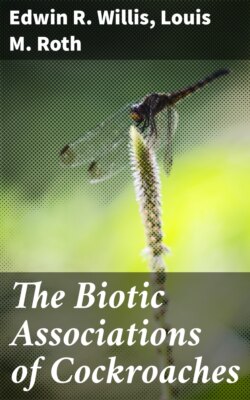Читать книгу The Biotic Associations of Cockroaches - Edwin R. Willis - Страница 338
На сайте Литреса книга снята с продажи.
Pycnoscelus surinamensis
ОглавлениеFlorida.—Under stones and rubbish; very abundant under coquina boulders in woods at Key West (Rehn and Hebard, 1905). "This species is common under planks, stones, and other debris on the ground ... also found at Long Key in the dry fibres at the base of the petioles of a coconut palm" (Rehn and Hebard, 1912). At Musa Isle, found burrowing in sand (Hebard, 1915). In fallen leaves and decaying wood in xeric and mesic hammock habitats (Friauf, 1953).
Hawaii.—The soil swarmed with young of various stages during the summer (Illingworth, 1915). In soil about roots of pineapple under mulching paper; feeding on pineapple roots (Illingworth, 1927, 1929).
Fakarava, Tuamoto Archipelago.—Numerous among dead leaves in tree holes (Cheesman, 1927).
West Indies.—Under decayed stalks of sugarcane and in siftings from mangrove swamps, Cuba. Under manure, bases of leaves of coconut palm, litter, logs, and stones on coral rock and in bromeliads, Jamaica. Under wood, tiles, and boards in stable yards; immature individuals bored into the soil, Puerto Rico. (Rehn and Hebard, 1927.)
Barbados.—Frequents cane fields (Tucker, 1952).
Puerto Rico.—"Altho primarily a xerophytic species: collected among dry stones on Mona Island, under dry cow dung at Boquerón, and under boxes at Guánica, it is reasonably common in the more humid parts of Puerto Rico" (Wolcott, 1950).
Virgin Islands, St. Croix.—Common under rubbish; frequently seen feeding on chicken feces around chicken roosts (Beatty, 1944). By feeding on chicken feces it may become the vector of the chicken eyeworm, Oxyspirura mansoni, as described in the references cited on page 204.
Egypt.—Large numbers were found in moist soil at the site of a manure pile (Chakour, 1942).
Germany.—Under greenhouse conditions the depth to which P. surinamensis penetrated the soil was determined; 21 dug down to a depth of 8 to 10 cm., 3 dug down 10 to 12 cm., but only one dug 13 cm. below the surface. Often the tubes in the soil ended in a chamber which the cockroach might not leave for several days; nymphs molted in such chambers and females bore their young there (Roeser, 1940).
